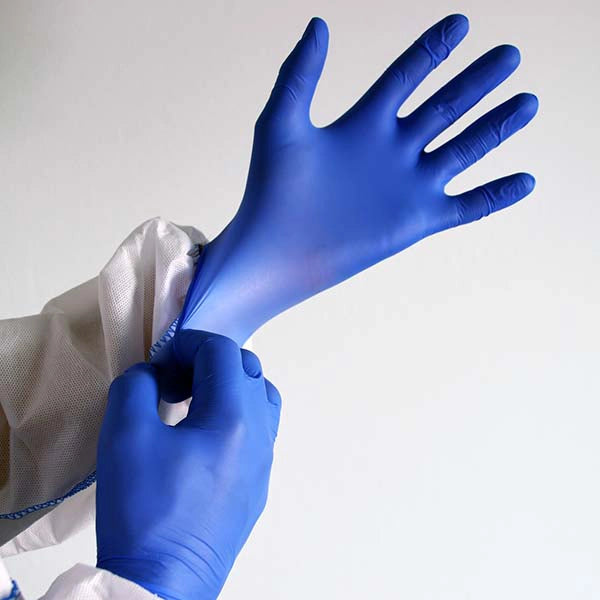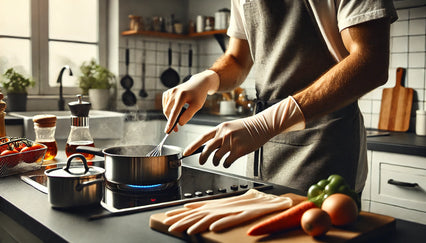If you've ever cooked or worked in a kitchen, you know the importance of protecting your hands. Whether you're handling hot pots and pans or working with sharp knives, your hands are constantly exposed to potential hazards.
That's where cooking gloves come in. These specialized gloves are designed to keep your hands safe while you prepare food.
In this article, we'll explore the different types of cooking gloves available and how to choose the right pair for your needs.
What are Cooking Gloves?
Cooking gloves are specialized hand protection designed for safe food handling and preparation. They provide a barrier between your hands and the food you're working with, helping to prevent cross-contamination and reduce the risk of foodborne illness.
Cooking gloves also protect your hands from heat, cuts, and other hazards in the kitchen. They allow you to handle hot pots, pans, and dishes without burning yourself. And if you're working with sharp knives or other tools, cooking gloves can help prevent cuts and other injuries.
Examples of Cooking Gloves
There are several types of cooking gloves available, each with its own unique features and benefits. Here are a few examples:
Nitrile gloves are a popular choice for cooking and food preparation. They're durable, puncture-resistant, and provide excellent protection against chemicals and bacteria. Nitrile gloves are also latex-free, making them a good option for people with latex allergies.
Latex gloves are another common type of cooking glove. They offer a snug, comfortable fit and provide excellent dexterity, making them a good choice for tasks that require precision. However, latex gloves are not suitable for individuals with latex allergies.
Vinyl gloves are a budget-friendly alternative to nitrile and latex gloves. They're lightweight, comfortable, and provide adequate protection for most cooking tasks. Vinyl gloves are also latex-free, making them a good choice for people with latex allergies.
Types of Gloves for Cooking
When it comes to cooking and food preparation, choosing the right type of gloves is essential for ensuring both safety and efficiency in the kitchen. Different tasks require different levels of protection, comfort, and dexterity, and understanding the various types of gloves available can help you make the best choice for your needs.
Polyethylene Gloves
Polyethylene gloves, often referred to as poly gloves, are an affordable and convenient option for cooking and food preparation. These gloves are lightweight, loose-fitting, and ideal for quick, low-risk tasks such as assembling sandwiches, handling pre-prepared foods, or plating salads.
They are designed for single-use applications, allowing you to change gloves frequently without incurring high costs, making them a practical choice in environments where hygiene and speed are priorities.
Neoprene Gloves
Neoprene gloves are the go-to choice for heavy-duty tasks in the kitchen, particularly those involving exposure to hot water, grease, and harsh cleaning chemicals. These gloves are thick, durable, and provide excellent protection against heat and potential chemical burns, making them ideal for dishwashing and deep cleaning.
Neoprene gloves are also highly resistant to cuts and punctures, ensuring that your hands remain protected during more demanding kitchen tasks, such as scrubbing pots and pans or handling sharp utensils.
5 Best Gloves for Cooking
To help you navigate the various options available, we’ve compiled a list of the five best gloves for cooking, each suited to different tasks and needs in the kitchen. Whether you’re handling raw meats, working with sharp tools, or performing heavy-duty cleaning, these gloves provide the protection, durability, and comfort required to keep your hands safe and your kitchen hygienic.
Below, you’ll find detailed descriptions of each glove, along with why they stand out as top choices for culinary tasks.
1. HandCare Black Nitrile Gloves - Exam Grade, Powder Free (6 Mil)
The HandCare Black Nitrile Gloves are a top choice for anyone looking for a reliable, high-quality glove for food preparation. These gloves are made from nitrile, a synthetic rubber that is both durable and puncture-resistant. The 6 Mil thickness provides excellent protection against chemicals and bacteria, making them ideal for handling raw meats, poultry, and other potentially hazardous foods. Additionally, these gloves are latex-free, which makes them a safe option for individuals with latex allergies.
Shop HandCare Black Nitrile Gloves and save up to 50% now
- Usage: Perfect for general kitchen tasks where protection from contaminants is essential. They are suitable for handling raw ingredients, especially those that could carry bacteria, such as raw meat.
- Why Choose This: Their durability and resistance to punctures make these gloves a must-have for maintaining food safety and preventing cross-contamination in the kitchen.
2. Dark Light Black Nitrile Gloves - Exam Grade, Powder Free (9 Mil)
The Dark Light Black Nitrile Gloves are designed for those heavy-duty kitchen tasks where maximum protection is required. With a thickness of 9 Mil, these gloves are thicker than standard nitrile gloves, providing enhanced protection against punctures, tears, and cuts. They are ideal for tasks that involve sharp tools, such as chopping or slicing, and are also resistant to oils and chemicals, making them perfect for deep frying and other greasy kitchen tasks.
Shop Dark Light Black Nitrile Gloves and save up to 50% now
- Usage: Ideal for high-risk kitchen activities, including handling sharp objects, dealing with hot oil, or performing extensive food prep that demands prolonged glove wear.
- Why Choose This: Their thickness ensures a strong barrier against physical hazards, while the nitrile material provides excellent tactile sensitivity, allowing for precise movements even in challenging conditions.
3. Polysilk by Shamrock Black Latex Gloves - Exam Grade, Powder Free (4 Mil)
The Polysilk by Shamrock Black Latex Gloves offer a balance of comfort and dexterity, making them ideal for precise kitchen tasks. With a 4 Mil thickness, these gloves provide a snug fit that allows for fine motor control, which is crucial for tasks such as garnishing, plating, or working with small ingredients. While they offer great tactile sensitivity, it’s important to note that latex gloves can cause allergic reactions in some individuals, so they should be avoided in kitchens where latex allergies are a concern.
Shop Polysilk by Shamrock Black Latex Gloves and save up to 50% now
- Usage: Best suited for tasks that require precision, such as intricate food prep or delicate handling of ingredients. They are also excellent for tasks where a high level of dexterity is needed.
- Why Choose This: The snug fit and superior dexterity make these gloves an excellent choice for chefs and kitchen staff who require precision in their work.
4. Disposable Poly Gloves - Powder Free Multi-Purpose Polyethylene Gloves
The Disposable Poly Gloves are a cost-effective solution for light-duty tasks in the kitchen. Made from polyethylene, these gloves are lightweight and designed for single-use, making them ideal for quick tasks like assembling sandwiches, handling pre-prepared foods, or serving meals. They are powder-free and latex-free, making them a safe option for all kitchen environments. Because they are inexpensive and designed for short-term use, these gloves are perfect for situations where frequent glove changes are necessary to maintain hygiene.
Shop Disposable Poly Gloves and save up to 50% now
- Usage: Ideal for low-risk, repetitive tasks where frequent glove changes are needed, such as food assembly, plating, or serving.
- Why Choose This: These gloves offer a budget-friendly option for maintaining hygiene without compromising on safety, especially in busy kitchens where speed and convenience are priorities.
5. Neoprene Chemical-Resistant Gloves
The Neoprene Chemical-Resistant Gloves are designed for heavy-duty kitchen tasks that involve exposure to harsh conditions, such as cleaning with strong chemicals, handling hot pots and pans, or deep-cleaning kitchen equipment. Neoprene is known for its resistance to chemicals, heat, and abrasion, making these gloves a robust choice for demanding kitchen environments. Despite their thickness, they offer good flexibility and dexterity, allowing users to perform tasks effectively while keeping their hands well-protected.
-
Usage: Perfect for tasks that require protection from heat, chemicals, or heavy-duty cleaning processes, such as dishwashing, oven cleaning, or handling hot kitchenware.
-
Why Choose This: Their chemical and heat resistance, combined with durability, make them indispensable for maintaining safety during the most challenging kitchen tasks.
How to Choose the Right Cooking Gloves
When selecting cooking gloves, consider the specific tasks you'll be using them for. Nitrile gloves are food-safe and ideal for handling raw meats and other potentially hazardous foods. Latex gloves offer superior dexterity for precise tasks, while vinyl and poly gloves are best for light-duty jobs and frequent glove changes.
Also, consider the size and fit of the gloves. Gloves that are too loose can make it difficult to handle tools and ingredients, while gloves that are too tight can be uncomfortable and restrict movement. Look for gloves that fit snugly but allow for flexibility and dexterity.
Finally, if you or anyone in your kitchen has a latex allergy, be sure to choose latex-free gloves like nitrile, vinyl, or poly. These alternatives provide similar protection and performance without the risk of allergic reactions.
Benefits of Using Cooking Gloves
Cooking gloves offer several key benefits that make them a valuable tool in any kitchen. First and foremost, they help prevent cross-contamination. When you handle raw meats, unwashed produce, or other potentially hazardous foods with your bare hands, you risk spreading harmful bacteria and foodborne illnesses to other surfaces, utensils, and ingredients. Wearing gloves creates a barrier between your hands and the food, minimizing the spread of contaminants.
In addition to preventing cross-contamination, cooking gloves also protect your hands from heat and injuries. Whether you're reaching into a hot oven, handling a sizzling pan, or working with sharp knives, gloves shield your hands from burns, cuts, and other kitchen hazards. This added layer of protection allows you to work more confidently and efficiently, without worrying about accidental injuries.
Finally, using cooking gloves helps maintain food safety standards in professional kitchens. Health department regulations and guidelines often require food service workers to wear gloves when handling ready-to-eat foods to prevent the spread of foodborne illnesses. By wearing gloves, you demonstrate a commitment to food safety and comply with these important regulations.
How to Choose the Right Cooking Gloves
When selecting the best gloves for cooking, it's important to consider the specific tasks you'll be performing in the kitchen. Nitrile gloves are a popular choice for handling raw meats and other potentially hazardous foods due to their durability and excellent protection against bacteria. For tasks requiring precision, such as delicate plating or garnishing, latex gloves provide a snug fit and enhanced dexterity. However, if you or your staff have latex allergies, vinyl or poly gloves are suitable latex-free alternatives for light-duty tasks and frequent glove changes.
Proper fit and comfort are also key factors when choosing cooking gloves. Gloves that are too loose can make it challenging to handle ingredients and tools, while overly tight gloves can restrict movement and cause discomfort. Look for gloves that fit snugly but still allow for flexibility and ease of movement. Many brands offer a range of sizes to accommodate different hand shapes and sizes, so be sure to measure your hand and consult the sizing chart before purchasing.
When it comes to food safety, always opt for gloves made from FDA-approved, food-grade materials. These materials have been rigorously tested and deemed safe for direct contact with food, minimizing the risk of contamination. Nitrile, latex, vinyl, and polyethylene are all common food-grade materials used in the production of disposable gloves. By choosing gloves made from these materials, you can ensure that your gloves meet the necessary safety standards for use in food preparation and service.
Tips for Using Cooking Gloves Effectively
To get the most out of your cooking gloves, it's important to use them correctly. One key tip is to change your gloves frequently. Replace them whenever you switch tasks or if they become torn, punctured, or contaminated. This helps prevent cross-contamination and ensures that your gloves remain effective barriers against bacteria and other hazards.
Proper handwashing is also essential when using cooking gloves. Always wash your hands thoroughly with soap and warm water before putting on a fresh pair of gloves. This removes any dirt, grime, or bacteria that could contaminate the gloves and potentially spread to food. After removing your gloves, wash your hands again to maintain good hygiene.
Storing your cooking gloves properly helps maintain their quality and effectiveness. Keep them in a clean, dry area away from potential contaminants like chemicals, dust, or moisture. Avoid storing gloves in direct sunlight or extreme temperatures, as this can degrade the material over time. If you're using reusable gloves, make sure they are completely dry before storing them to prevent bacterial growth.
When it's time to don a new pair of gloves, follow the proper technique to avoid contaminating the exterior. Grasp the glove by the cuff and slide your hand in, being careful not to touch the outside of the glove with your bare skin. Once the glove is on, adjust it for a comfortable fit and check for any tears or punctures before handling food.
Remember, cooking gloves are a valuable tool in the kitchen, but they're not a substitute for good hygiene practices. Always follow proper food safety guidelines, including regular handwashing, surface sanitizing, and temperature control, to ensure that your food is safe and delicious.
Where to Buy the Best Gloves for Cooking
Ultimately, the best gloves for cooking are those that meet your specific needs while complying with food safety regulations and guidelines. By choosing gloves that provide the necessary protection, comfort, and peace of mind, you can focus on creating delicious meals without compromising on hygiene or safety.
Choosing the right cooking gloves is essential for maintaining safety and hygiene in the kitchen. gloves.com offers a wide selection of high-quality gloves to meet your specific needs, ensuring durability, comfort, and protection.





